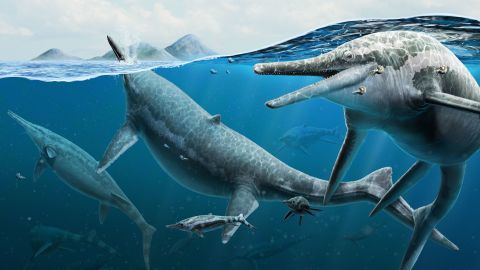Sign up for CNN’s Wonder Theory science newsletter. Explore the universe with news of amazing discoveries, scientific advances, and more.
CNN
–
The final resting place of dozens of huge prehistoric marine reptiles lies in what is now Nevada Humboldt-Toiapee National Forest.
But why did ichthyosaurs die out in such large numbers at this particular fossil site? 230 million years ago has long been a source of debate among paleontologists. Scientifically Known as Shonisaurus popularis, it resembled a giant dolphin and grew to be at least 50 feet (15.2 meters) long.
Theories have pointed to a mass stranding event or that the ichthyosaurs were poisoned by toxins from an algae bloom.
Now, though, scientists say they’ve ruled out those hypotheses and have a much better understanding of why 37 ancient creatures died at the same location. The researchers believe their findings shed light on a fascinating side of the reptile species Reproductive behaviour, which is shared by some marine mammals today.
said study co-author Nicholas Benson, a research geologist W Curator of the Smithsonian National Museum of Natural History In Washington, D.C., in a press release.
“This means that the kind of behavior we observe today in whales has been around for more than 200 million years.”
Current whale species, including blue whales and humpback whales, routinely migrate across the oceans to breed and give birth in waters where predators are scarce. Many whales congregate year after year along the same stretches of coast.
“There are other examples of ichthyosaur fetuses and newborns, but this is the first time we have solid evidence of reproductive group behavior,” the study said. Co-author Randy Ermes, senior curator and curator of paleontology at the Natural History Museum of Utah in Salt Lake City.
“We know this is something that many large marine vertebrates display at present, so it makes sense that similar behavior might have happened in the past. But we didn’t really know to what extent, especially with groups of Extinct animals such as ichthyosaurs, which have no living relatives.”
Researchers from the US, UK and Belgium used new technologies, such as 3D modeling, to investigate the fossil site, which is part of the Berlin Ichthyosaurus State Park.

The team examined the chemical composition of the rocks surrounding the fossils and found no evidence of any sudden increases in organic matter, such as algae, that might have deprived the organisms of oxygen.
Geological evidence also indicates that ichthyosaur bones sank to the bottom of the sea, which then covered much of present-day Nevada. rather than a length of shoreline shallow enough to indicate that marine reptiles have washed themselves ashore.
Furthermore, the team noted that the fossils were mostly of adult ichthyosaurs, with very few other marine vertebrates. There were no minor ichthyosaurs.
A breakthrough occurred when the remains of small ichthyosaurs were identified both among new fossils collected at the site and within older museum collections. Delicate X-ray examinations with computed tomography revealed that the small bones belonged to embryonic and newborn ichthyosaurs.
“Once it became clear that there was nothing they could eat here, and there were large adult Choniosaurus with fetuses and newborns but no juveniles, we began to seriously consider whether this might be a birthing place,” said lead author Neil Kelly. , research assistant professor of earth and environmental sciences at Vanderbilt University in Nashville, Tennessee, in the news release.
The authors conclude that the area was a favored birthing ground for prehistoric creatures—and that the large number of fossil remains was a result of the large numbers of ichthyosaurs that congregated there, perhaps over millions of years, to give birth.
“This is a clear ecological signal, we argue, that this was a place where Shonisaurus was giving birth, very similar to today’s whales. Now we have evidence that this type of behavior is 230 million years old,” Benson said.
the magazine Current Biology The research was published on Monday.

“Certified music scholar. Freelance analyst. Social mediaholic. Hipster-friendly web nerd. Zombie buff.”
